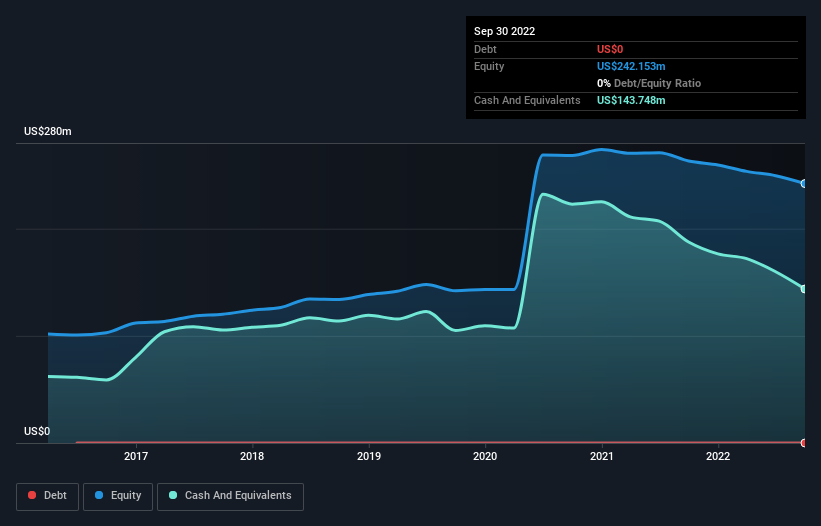- United States
- /
- Medical Equipment
- /
- NasdaqGS:CSII
We're Not Very Worried About Cardiovascular Systems' (NASDAQ:CSII) Cash Burn Rate

Even when a business is losing money, it's possible for shareholders to make money if they buy a good business at the right price. For example, although software-as-a-service business Salesforce.com lost money for years while it grew recurring revenue, if you held shares since 2005, you'd have done very well indeed. Having said that, unprofitable companies are risky because they could potentially burn through all their cash and become distressed.
Given this risk, we thought we'd take a look at whether Cardiovascular Systems (NASDAQ:CSII) shareholders should be worried about its cash burn. For the purpose of this article, we'll define cash burn as the amount of cash the company is spending each year to fund its growth (also called its negative free cash flow). We'll start by comparing its cash burn with its cash reserves in order to calculate its cash runway.
View our latest analysis for Cardiovascular Systems
How Long Is Cardiovascular Systems' Cash Runway?
You can calculate a company's cash runway by dividing the amount of cash it has by the rate at which it is spending that cash. When Cardiovascular Systems last reported its balance sheet in September 2022, it had zero debt and cash worth US$144m. Looking at the last year, the company burnt through US$31m. Therefore, from September 2022 it had 4.6 years of cash runway. There's no doubt that this is a reassuringly long runway. Depicted below, you can see how its cash holdings have changed over time.

How Well Is Cardiovascular Systems Growing?
Notably, Cardiovascular Systems actually ramped up its cash burn very hard and fast in the last year, by 130%, signifying heavy investment in the business. As if that's not bad enough, the operating revenue also dropped by 7.5%, making us very wary indeed. Considering both these metrics, we're a little concerned about how the company is developing. Clearly, however, the crucial factor is whether the company will grow its business going forward. So you might want to take a peek at how much the company is expected to grow in the next few years.
How Hard Would It Be For Cardiovascular Systems To Raise More Cash For Growth?
Even though it seems like Cardiovascular Systems is developing its business nicely, we still like to consider how easily it could raise more money to accelerate growth. Companies can raise capital through either debt or equity. Many companies end up issuing new shares to fund future growth. By comparing a company's annual cash burn to its total market capitalisation, we can estimate roughly how many shares it would have to issue in order to run the company for another year (at the same burn rate).
Since it has a market capitalisation of US$614m, Cardiovascular Systems' US$31m in cash burn equates to about 5.0% of its market value. That's a low proportion, so we figure the company would be able to raise more cash to fund growth, with a little dilution, or even to simply borrow some money.
So, Should We Worry About Cardiovascular Systems' Cash Burn?
Even though its increasing cash burn makes us a little nervous, we are compelled to mention that we thought Cardiovascular Systems' cash runway was relatively promising. Based on the factors mentioned in this article, we think its cash burn situation warrants some attention from shareholders, but we don't think they should be worried. Its important for readers to be cognizant of the risks that can affect the company's operations, and we've picked out 2 warning signs for Cardiovascular Systems that investors should know when investing in the stock.
Of course Cardiovascular Systems may not be the best stock to buy. So you may wish to see this free collection of companies boasting high return on equity, or this list of stocks that insiders are buying.
New: AI Stock Screener & Alerts
Our new AI Stock Screener scans the market every day to uncover opportunities.
• Dividend Powerhouses (3%+ Yield)
• Undervalued Small Caps with Insider Buying
• High growth Tech and AI Companies
Or build your own from over 50 metrics.
Have feedback on this article? Concerned about the content? Get in touch with us directly. Alternatively, email editorial-team (at) simplywallst.com.
This article by Simply Wall St is general in nature. We provide commentary based on historical data and analyst forecasts only using an unbiased methodology and our articles are not intended to be financial advice. It does not constitute a recommendation to buy or sell any stock, and does not take account of your objectives, or your financial situation. We aim to bring you long-term focused analysis driven by fundamental data. Note that our analysis may not factor in the latest price-sensitive company announcements or qualitative material. Simply Wall St has no position in any stocks mentioned.
About NasdaqGS:CSII
Cardiovascular Systems
Cardiovascular Systems, Inc., a medical technology company, develops and commercializes solutions to treat peripheral and coronary artery diseases in the United States and internationally.
Flawless balance sheet and overvalued.
Similar Companies
Market Insights
Community Narratives



